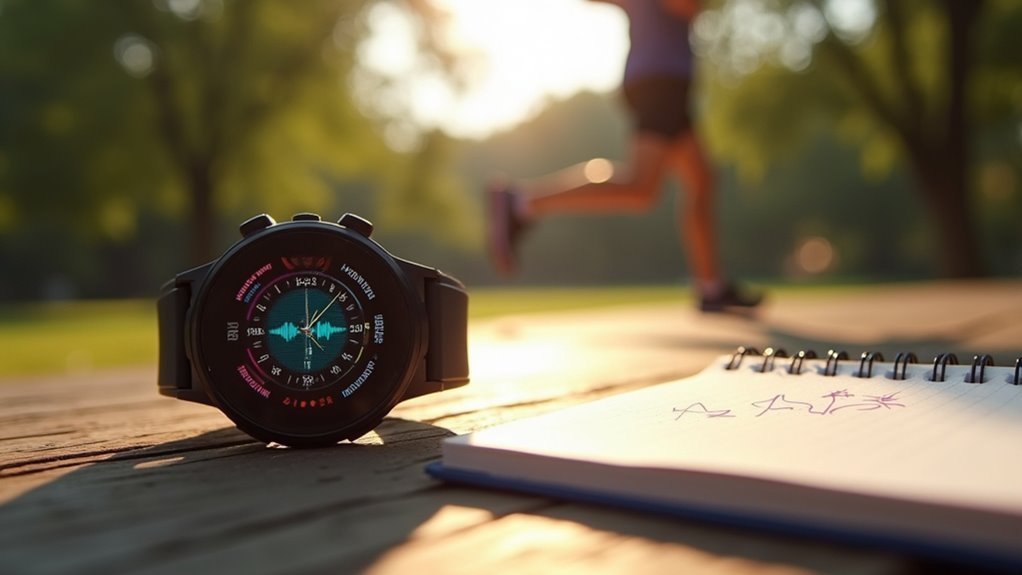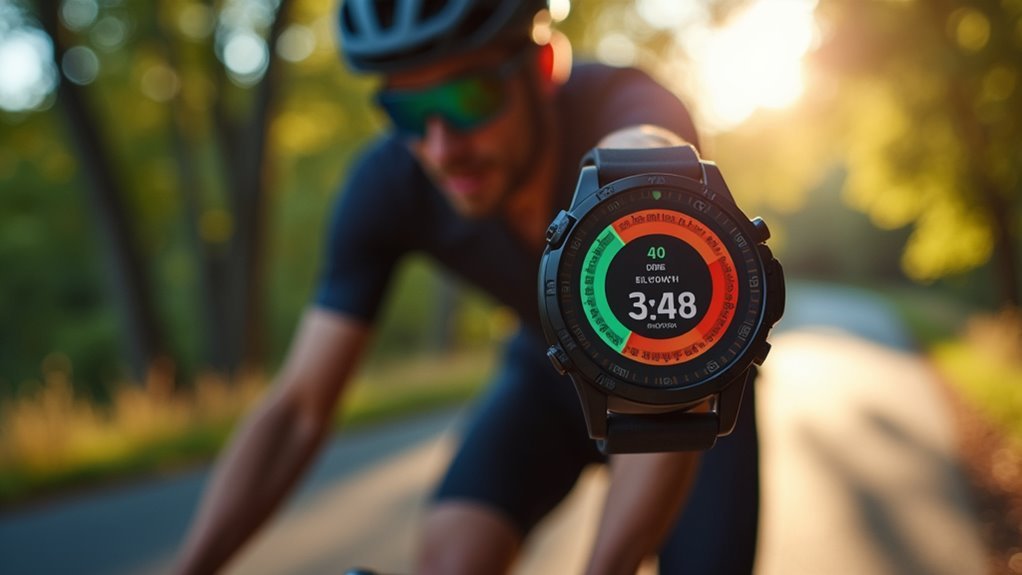To trust your COROS power data, calibrate your power meter before every ride to establish accurate zero load readings. Conduct proper FTP tests indoors using consistent warm-up protocols to create reliable baselines. Confirm your heart rate monitor fits snugly against clean, dry skin for precise measurements. Keep your device software updated and maintain consistent GPS settings. Monitor environmental factors like temperature changes that can affect sensor accuracy by up to 2% per 10°C. Cross-reference power readings across multiple training sessions to identify patterns and potential sensor issues. These foundational steps will reveal deeper insights into your performance analytics.
Calibrate Your Power Meter Before Every Ride

Before you clip in and start pedaling, you’ll want to calibrate your power meter to guarantee accurate readings throughout your ride. Calibration sets the zero load state on your power meter, which is vital for precise data collection.
Weather changes, temperature shifts, and equipment swaps can all affect your power meter’s accuracy, making pre-ride calibration essential.
Your COROS DURA supports calibration with various power meters and will display both the calibration status and final value once complete.
Different power meters require specific calibration methods, so you’ll need to consult your device’s manual for proper procedures. Some devices calibrate automatically, while others need manual calibration.
For optimal results, calibration is also known as zero offset, which indicates there is no load being applied to the power meter during the calibration process.
Establish Accurate FTP Through Proper Testing
Once you’ve got your power meter calibrated, establishing an accurate Functional Threshold Power (FTP) becomes your next critical step for meaningful training data.
COROS’s FTP test protocol offers a smarter approach than traditional 20-minute tests, using only 6-9 minutes of threshold intensity to reduce fatigue while maintaining accuracy.
For best results, you’ll want to:
- Test indoors on a trainer to eliminate wind, gradient, and traffic variables
- Follow consistent warm-up protocols before each test for repeatable baseline conditions
- Ensure proper bike setup to prevent mechanical issues from affecting power reliability
- Let EvoLab automatically update your training zones based on accumulated data
Your FTP represents the highest average power you can sustain for approximately 45 minutes, forming the foundation for all seven power zones that’ll guide your future training intensity. Power data provides real-time intensity feedback that helps you maintain optimal effort levels during each training session.
Ensure Consistent Heart Rate Data Collection

While power data provides the mechanical foundation for training analysis, heart rate data reveals how your cardiovascular system responds to that workload. To guarantee accurate readings, position your COROS device snugly against clean, dry skin with warm hands to improve blood flow. Minimize excessive wrist movement during exercise and regularly calibrate against a heart rate strap when available.
Use your device consistently across different activities to build thorough baseline data. Sync regularly with the app to track changes over time and analyze patterns within your established heart rate zones.
For high-intensity workouts, consider using the COROS Heart Rate Monitor at your biceps to reduce signal delay. The device uses optical heart rate technology that emits light into the skin and reflects back into the sensor for accurate readings. Compare readings with chest strap data periodically to validate accuracy and maintain trust in your cardiovascular training metrics.
Maintain Regular Software Updates and Device Settings
As COROS continuously refines their algorithms and sensor integrations, keeping your device updated guarantees you’re capturing the most accurate power measurements possible.
The January 2025 update introduced valuable features that directly impact power data reliability.
Regular maintenance guarantees your COROS device delivers consistent, trustworthy power metrics:
- Check for firmware updates through the COROS app’s Profile Page by tapping the watch icon
- Update the COROS app first before installing watch updates to prevent compatibility issues
- Name your external sensors for easier identification and better data management
- Enable low-battery alerts for paired sensors to avoid missing critical power data
Updates typically install within 10 minutes on compatible devices.
Don’t overlook temperature unit settings and factory reset options when troubleshooting power data inconsistencies. The upcoming April 2025 update will focus on enhancing user experience and introducing additional features based on community feedback.
Validate Power Zone Calculations Against Performance

The accuracy of your COROS power zones hinges on proper FTP baseline establishment and real-world performance validation. You’ll need to regularly test your zones against actual performance to guarantee they’re dialed in correctly.
Monitor your Training Load scores during workouts. If they’re consistently higher than expected for perceived effort, your power zones likely need adjustment. Compare heart rate integration with power output to validate FTP accuracy, and use VO2 max intervals to confirm your anaerobic endurance zones.
| Zone | FTP Percentage | Workout Type | Validation Method |
|---|---|---|---|
| Recovery | Below 56% | Easy rides | Heart rate correlation |
| Aerobic Endurance | 56-75% | Base training | Sustained effort comfort |
| Tempo | 76-90% | Focused rides | Breathing pattern |
| Threshold | 91-105% | FTP intervals | Maximum sustainable effort |
Track FTP changes over time and adjust zones manually when automatic updates don’t reflect your actual fitness improvements. EvoLab automatically updates your power zones using data from your most recent 12 Moderate Intensity rides within a 60-day period.
Monitor Environmental Factors That Affect Readings
Your COROS power meter’s accuracy isn’t just about the device itself—environmental conditions greatly impact the readings you’ll see during rides.
Temperature swings can shift your power data by up to 2% per 10°C change, while wind conditions can affect readings by as much as 10% depending on direction and intensity.
Road surface quality also matters, as rough pavement creates inconsistent pedal strokes that translate to variable power measurements even when your actual effort remains steady. High humidity levels can affect electrical conductivity in your power meter, potentially leading to irregular measurements over time.
Weather Impact on Accuracy
Environmental conditions create significant variables that can affect your COROS device’s power accuracy, yet most current analytics don’t account for these factors.
While your device captures reliable data, understanding weather’s impact helps you interpret readings more effectively.
Temperature variations affect sensor performance, particularly with wrist-based devices where body heat can skew readings.
The COROS POD 2 provides more accurate ambient temperature data by measuring away from your skin. When worn on the foot, it also delivers enhanced cadence tracking compared to wrist-based measurements.
Key weather factors to monitor:
- Wind conditions – Strong headwinds or tailwinds can cause power fluctuations if environmental compensation isn’t applied
- Temperature extremes – Hot climates and direct sunlight impact sensor calibration
- Humidity levels – High humidity affects performance but isn’t factored into current metrics
- Precipitation – Rain or snow alters running efficiency without being reflected in analytics
Road Conditions Matter
While weather conditions influence your COROS device’s performance, terrain and structural elements create equally significant challenges for accurate power data collection.
Heavy tree coverage interferes with GPS signals, reducing data accuracy during forest runs. Tall buildings in urban areas obstruct signals, leading to less reliable readings. Large water bodies can refract GPS signals, causing measurement discrepancies.
You’ll need alternative solutions for challenging environments. The COROS POD 2 enhances GPS performance using internal sensors to identify your actual path.
Switch to Dual Frequency mode in canyons and urban centers where interference is heavy. For most COROS models, use GPS/Glonass/Beidou settings to improve signal reception. Allow your device to soak for an additional minute after acquiring signal to ensure optimal accuracy.
Always wait for solid satellite signal strength before starting activities, and pause your workouts when moving indoors to maintain data integrity.
Cross-Reference Data Across Multiple Training Sessions
Although individual training sessions can provide valuable insights, cross-referencing your COROS power data across multiple workouts reveals patterns and inconsistencies that wouldn’t be apparent from isolated measurements.
Systematic tracking across sessions helps you identify trends in your performance data and spot potential sensor issues. When you maintain consistent device settings and calibration procedures, you’ll create reliable baseline measurements for comparison. Power data serves as a key intensity metric that directly influences your Training Load calculations and overall training progression.
Consistent tracking and calibration create reliable baselines that reveal performance trends and help identify sensor problems across training sessions.
- Track power data systematically across all training sessions to identify performance trends and data inconsistencies
- Maintain consistent device calibration before each workout to guarantee reliable measurements and avoid false discrepancies
- Synchronize data across platforms like Strava and TrainingPeaks for thorough comparative analysis
- Account for environmental factors such as temperature and humidity that may affect sensor accuracy between sessions
Frequently Asked Questions
How Do I Know if My COROS Optical Heart Rate Is Accurate Enough?
You’ll know your COROS optical heart rate’s accurate enough by comparing readings against a chest strap during various intensities, ensuring consistent data within 3-5 bpm difference consistently.
What Should I Do if My Power Data Seems Inconsistent Between Rides?
Check your power meter calibration before each ride and guarantee stable sensor connections. Update firmware regularly, verify GPS accuracy, and restart both devices if readings seem off. Contact COROS support for persistent issues.
Can Weather Conditions Like Temperature and Humidity Affect My Power Readings?
Weather conditions don’t directly affect your COROS power readings since they’re measured by external power meters. However, temperature and humidity can impact your physical performance, making the same power output feel harder or easier.
How Often Should I Replace the Battery in My Power Meter?
You should replace your COROS POD battery when the red indicator flashes, typically every few months depending on usage frequency. There’s no fixed schedule—monitor for low battery alerts instead.
Why Does My FTP Seem Lower on COROS Compared to Other Platforms?
Your FTP appears lower on COROS because different platforms use varying algorithms and data requirements. Check your power meter calibration, verify consistent testing conditions, and consider algorithm differences when comparing FTP values.
In Summary
You’ll build confidence in your Coros power data by consistently following these seven practices. Don’t skip calibration or FTP testing—they’re your foundation for accurate readings. Keep your device updated and cross-check your numbers regularly to catch any inconsistencies. Remember, environmental factors can throw off your data, so account for temperature and humidity changes. When you’re diligent about these steps, you’ll trust your power metrics completely during training and racing.





Leave a Reply